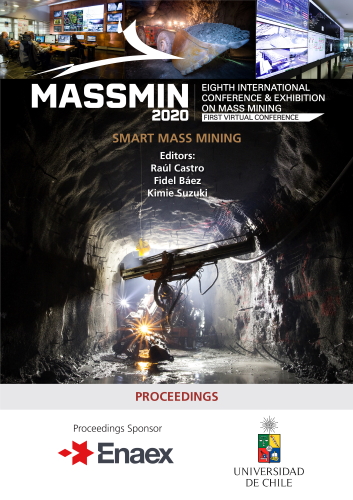Methodology implemented for ore pillar recovery through blasting engineering and explosive technology solutions

|
Authors: Pavez, J; Rios, E; Calderon, S; Rucal, F |
This paper is hosted with the kind permission of Lulea University of Technology, International Conference & Exhibition on Mass Mining, 2024.
DOI https://doi.org/10.36487/ACG_repo/2063_40
Cite As:
Pavez, J, Rios, E, Calderon, S & Rucal, F 2020, 'Methodology implemented for ore pillar recovery through blasting engineering and explosive technology solutions', in R Castro, F Báez & K Suzuki (eds), MassMin 2020: Proceedings of the Eighth International Conference & Exhibition on Mass Mining, University of Chile, Santiago, pp. 598-617, https://doi.org/10.36487/ACG_repo/2063_40
Abstract:
A mine operation defined the need to recover 640,000 tons of mineral located between two levels of the mine, distributed between the rib and crown pillars. The sector was located in an area of geological structures and old stopes that due to their condition made it necessary to carry out the recovery in one event. The challenges identified were to blast a large volume of rock while defining a blast sequence so that vibrations did not negatively impact the nearby community or the mine infrastructure. The drilling considered different types of design, depending on the blast areas in the up/down holes, with a total of 46,500 meters. The use of Anfo is usual in mine operations but was discarded because of issues with humidity/water and the need for good fragmentation to assure extraction continuity. Instead bulk emulsions based on Ammonium Nitrate (ANE) were selected and 250 tons of explosive were loaded and distributed over 2,630 explosive decks and 32 days. For precision, flexibility, full programming, 30-second window times, and the multiples decks, the use of electronic detonators (i-kon ™ III) and the Blaster3000 system were defined, which have the capacity to work in a programmed, synchronized manner (masterslave), with up to 21,000 electronic detonators of which in this case 4,913 detonators were used. Two points were defined for vibration measurement and control: the first was an underground office area and the second was on the surface. The mass blast was successful at the level of geometry and fragmentation at the base level, allowing continuous extraction (according to weekly plan) for six to seven months. The vibrations in the local community at a distance of 1,500 meters registered a value of 0.75 mm/s, which according to the USBM & Goldman Human Perception criterion the level was below the perceptible. It should be noted that this blast is among the 10 largest in the world in terms of volume and the first in number of programmed detonators and initiation in a single event.
References:
Case Study Underground Mass Blast St Barbara Southern Cross, Marvel Loch, Australia.
Holmberg, R 1979, ‘Design of Tunnel Perimeter Blast-hole Patterns to Prevent Rock Damage’.
JKTech 1998, ‘JKSimblast - Blast simulation, evaluation and management. 2D Ring, Underground Blast Design’, Queensland, Australia.
© Copyright 2026, Australian Centre for Geomechanics (ACG), The University of Western Australia. All rights reserved.
View copyright/legal information
Please direct any queries or error reports to repository-acg@uwa.edu.au
View copyright/legal information
Please direct any queries or error reports to repository-acg@uwa.edu.au
